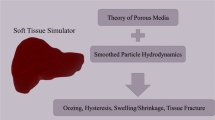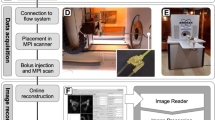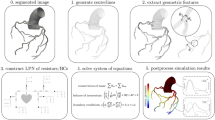Abstract
A tandem of particle-based computational methods is adapted to simulate injury and hemorrhage in the human body. In order to ensure anatomical fidelity, a three-dimensional model of a targeted portion of the human body is reconstructed from a dense sequence of CT scans of an anonymized patient. Skin, bone and muscular tissue are distinguished in the imaging data and assigned with their respective material properties. An injury geometry is then generated by simulating the mechanics of a ballistic projectile passing through the anatomical model with the material point method. From the injured vascular segments identified in the resulting geometry, smoothed particle hydrodynamics (SPH) is employed to simulate bleeding, based on inflow boundary conditions obtained from a network model of the systemic arterial tree. Computational blood particles interact with the stationary particles representing impermeable bone and skin and permeable muscular tissue through the Brinkman equations for porous media. The SPH results are rendered in post-processing for improved visual fidelity. The overall simulation strategy is demonstrated on an injury scenario in the lower leg.






Similar content being viewed by others
References
Akinci N, Ihmsen M, Akinci G, Solenthaler B, Teschner M (2012) Versatile rigid-fluid coupling for incompressible SPH. ACM Trans Graph 31(4), Art ID 62. doi:10.1145/2185520.2185558
Avolio AP (1980) Multi-branched model of the human arterial system. Med Biol Eng Comput 18(6):709–718
Basdogan C, Ho C-H, Srinivasan MA (2001) Virtual environments for medical training: graphical and haptic simulation of laparoscopic common bile duct exploration. IEEE/ASME Trans Mechatron 6(3):269–285
Boisvert J, Poirier G, Borgeat L, Godin G (2013) Real-time blood circulation and bleeding model for surgical training. IEEE Trans Biomed Eng 60(4):1013–1022
Bridson R (2007) Fast poisson disk sampling in arbitrary dimensions. In: ACM SIGGRAPH 2007 Sketches. SIGGRAPH ’ 07:2007
Courtecuisse H, Allard J, Kerfriden P, Bordas SP, Cotin S, Duriez C (2014) Real-time simulation of contact and cutting of heterogeneous soft-tissues. Med Image Anal 18(2):394–410
Dehnen W, Aly H (2012) Improving convergence in smoothed particle hydrodynamics simulations without pairing instability. Mon Not R Astron Soc 425(2):1068–1082
Desbrun M, Gascuel MP (1996) Smoothed particles: a new paradigm for animating highly deformable bodies. In: Computer animation and simulation ’96 proceedings of EG workshop on animation and simulation. Springer, pp 61–76
Durlofsky L, Brady JF (1987) Analysis of the brinkman equation as a model for flow in porous media. Phys Fluids 30:3329–3341
Frank P, Eldredge JD, Benharash P, Dutson EP (2016) Real-time numerical simulation of the cardiovascular system and autoregulatory mechanisms in response to hemorrhagic injury. In: Preparation
Gallagher AG, Ritter EM, Champion H, Higgins G, Fried Marvin P, Moses Gerald, Smith C Daniel, Satava Smith (2005) Virtual reality simulation for the operating room: proficiency-based training as a paradigm shift in surgical skills training. Ann Surg 241(2):364–372
Gingold RA, Monaghan JJ (1977) Smoothed particle hydrodynamics: theory and application to non-spherical stars. MNRAS 181:375–389
Horvath CJ, Solenthaler B (2013) Mass preserving multi-scale sph. In: Pixar Technical Memo 13-04, Pixar Animation Studios
Jiang C, Schroeder C, Selle A, Teran J, Stomakhin A (2015) The affine particle-in-cell method. ACM Trans Graph 34(4):51:1–51:10
Kellman J (2014) Adaptive response-time-based category sequencing in perceptual learning. Vis Res 99:111–123
Krasne S, Hillman JD, Kellman PJ, Drake TA et al (2013) Applying perceptual and adaptive learning techniques for teaching introductory histopathology. J Pathol Inform 4(1):34
Kühnapfel U, Cakmak HK, Maaß H (2000) Endoscopic surgery training using virtual reality and deformable tissue simulation. Comput Graph 24(5):671–682
Liu A, Tendick F, Cleary K, Kaufmann C (2003) A survey of surgical simulation: applications, technology, and education. Presence Teleoperators Virtual Environ 12(6):599–614
Lucy LB (1977) Numerical study of liquid composite molding using a smoothed particle hydrodynamics method. Astron J 82:1013–1024
Meier U, López O, Monserrat C, Juan MC, Alcaniz M (2005) Real-time deformable models for surgery simulation: a survey. Comput Methods Programs Biomed 77(3):183–197
Müller M, Charypar D, Gross M (2003) Particle-based fluid simulation for interactive applications. In: Proceedings of the 2003 ACM SIGGRAPH/Eurographics symposium on computer animation
Müller M, Schirm S, Teschner M (2003) Interactive blood simulation for virtual surgery based on smoothed particle hydrodynamics. Technol Health Care 12:25–31
Museth K (2014) A flexible image processing approach to the surfacing of particle-based fluid animation (invited talk). In: Mathematical progress in expressive image synthesis I, volume 4 of mathematics for industry, pp 81–84
Oger Guillaume, Doring Mathieu, Alessandrini Bertrand, Ferrant Pierre (2007) An improved sph method: Towards higher order convergence. Journal of Computational Physics 225(2):1472–1492
Ram D, Gast T, Jiang C, Schroeder C, Stomakhin A, Teran J, Kavehpour P (2015) A material point method for viscoelastic fluids, foams and sponges. In: Proceedings of the 14th ACM SIGGRAPH / Eurographics symposium on computer animation, SCA ’15, pp 157–163
Solenthaler B, Gross M (2011) Two-scale particle simulation. In: Proceedings of ACM SIGGRAPH 30:2011
Stam J, Fiume E (1995) Depicting fire and other gaseous phenomena using diffusion processes. In: Proceedings of the 22nd annual conference on computer graphics and interactive techniques, pp 129–136. ACM
Stergiopulos N, Young DF, Rogge TR (1992) Computer simulation of arterial flow with application to arterial and aortic stenoses. J Biomech 25(12):1477–1488
Stomakhin A, Schroeder C, Chai L, Teran J, Selle A (2013) A material point method for snow simulation. ACM Trans Graph 32(4):1021–10210
Stomakhin A, Schroeder C, Jiang C, Chai L, Teran J, Selle A (2014) Augmented MPM for phase-change and varied materials. ACM Trans Graph 33(4):138:1–138:11
Su D, Ma R, Zhur L (2011) Numerical study of liquid composite molding using a smoothed particle hydrodynamics method. Special Top Rev Porous Media Int J 2(3):205–212
Sulsky D, Zhou S-J, Schreyer HL (1995) Application of a particle-in-cell method to solid mechanics. Comput Phys Commun 87(1–2):236–252
Womersley JR (1957) Oscillatory flow in arteries: the constrained elastic tube as a model of arterial flow and pulse transmission. Phys Med Biol 2:178–187
Acknowledgements
This work has been supported by the Office of Naval Research under Grant N00014-13-C-0357, monitored by Dr. Ray Perez.
Author information
Authors and Affiliations
Corresponding author
Ethics declarations
Conflict of interest
The authors declare that they have no conflict of interest.
Ethical approval
All procedures performed in studies involving human participants were in accordance with the ethical standards of the institutional and/or national research committee and with the 1964 Helsinki Declaration and its later amendments or comparable ethical standards.
Electronic supplementary material
Below is the link to the electronic supplementary material.
Rights and permissions
About this article
Cite this article
Chong, K., Jiang, C., Ram, D. et al. Visualization of vascular injuries in extremity trauma. Med Biol Eng Comput 55, 1709–1718 (2017). https://doi.org/10.1007/s11517-017-1619-9
Received:
Accepted:
Published:
Issue Date:
DOI: https://doi.org/10.1007/s11517-017-1619-9




